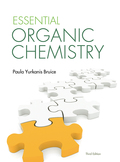
Concept explainers
(a)
Interpretation:
The number of ATP from conversion of glycerol to pyruvate without including the stage 4 present in catabolism should be calculated.
Concept introduction:
Glycolysis: It is pathway which describes conversion of one molecule of glucose into 2
pyruvate molecules. It involves totally 10 set of reactions with it.
Protein catabolism: It is defined as breakdown of proteins into smaller units that is into amino acids gets transported finally
Citric Acid Cycle: It involves 8 series reaction which converts acetyl group present in acetyl coenzyme A into 2
Substrate: The molecule where the reaction takes place with help of enzymes.
Enzyme: The proteins that helps
Oxidation: The oxidation is reaction that involves addition of oxygen atom or loss of electrons or removal of hydrogen atom present in the chemical compound.
Reduction: It involves removal of oxygen or addition of hydrogen to the chemical compound.
Coenzyme: They are non-proteins molecules which helps enzymes for catalyzing the reaction.
(b)
Interpretation:
The number of ATP from conversion of glycerol to pyruvate including the stage 4 present in catabolism should be determined.
Concept introduction:
Glycolysis: It is pathway which describes conversion of one molecule of glucose into 2
pyruvate molecules. It involves totally 10 set of reactions with it.
Protein catabolism: It is defined as breakdown of proteins into smaller units that is into amino acids gets transported finally polymerized to give new proteins.
Citric Acid Cycle: It involves 8 series reaction which converts acetyl group present in acetyl coenzyme A into 2
Substrate: The molecule where the reaction takes place with help of enzymes.
Enzyme: The proteins that helps chemical reaction to occur.
Oxidation: The oxidation is reaction that involves addition of oxygen atom or loss of electrons or removal of hydrogen atom present in the chemical compound.
Reduction: It involves removal of oxygen or addition of hydrogen to the chemical compound.
Coenzyme: They are non-proteins molecules which helps enzymes for catalyzing the reaction.
Want to see the full answer?
Check out a sample textbook solution
Chapter 19 Solutions
EBK ESSENTIAL ORGANIC CHEMISTRY
- For a CARS experiment on a Raman band 918 cm-1, if omega1= 1280 nm, calculate the omega2 in wavelength (nm) and the CARS output in wavelength (nm).arrow_forwardI need help with the following questionarrow_forwardFor CARS, which statement is not true regarding its advantages? a) Contrast signal based on vibrational characteristics, no need for fluorescent tagging. b) Stronger signals than spontaneous Raman. c) Suffers from fluorescence interference, because CARS signal is at high frequency. d) Faster, more efficient imaging for real-time analysis. e) Higher resolution than spontaneous Raman microscopy.arrow_forward
- Draw the major product of the Claisen condensation reaction between two molecules of this ester. Ignore inorganic byproducts. Incorrect, 5 attempts remaining 1. NaOCH3/CH3OH 2. Acidic workup Select to Draw O Incorrect, 5 attempts remaining The total number of carbons in the parent chain is incorrect. Review the reaction conditions including starting materials and/or intermediate structures and recount the number of carbon atoms in the parent chain of your structure. OKarrow_forwardUsing a cell of known pathlength b = 1.25115 x 10-3 cm, a water absorption spectrum was measured. The band at 1645 cm-1, assigned to the O-H bending, showed an absorbance, A, of 1.40. a) Assuming that water density is 1.00 g/mL, calculate the water molar concentration c (hint: M= mole/L) b) Calculate the molar absorptivity, a, of the 1645 cm-1 band c) The transmitted light, I, can be written as I= Ioexp(-xb), where x is the absorption coefficient (sometimes designated as alpha), Io is the input light, and b is the cell pathlength. Prove that x= (ln10)*x*c d) Calculate x for the 1645 cm-1 bandarrow_forwardConvert 1.38 eV into wavelength (nm) and wavenumber (cm-1) (c = 2.998 x 108 m/s; h = 6.626 x 10-34 J*s).arrow_forward
- Can you help me understand the CBC method on metal bridging by looking at this problem?arrow_forwardA partir de Aluminio y Co(NO3)2ꞏ6H2O, indicar las reacciones a realizar para obtener Azul de Thenard (Al2CoO4).arrow_forwardTo obtain Thenard Blue (Al2CoO4), the following reaction is correct (performed in an oven):Al(OH)3 + Co(OH)2 → Al2CoO4 + 4 H2Oarrow_forward
 Chemistry for Today: General, Organic, and Bioche...ChemistryISBN:9781305960060Author:Spencer L. Seager, Michael R. Slabaugh, Maren S. HansenPublisher:Cengage Learning
Chemistry for Today: General, Organic, and Bioche...ChemistryISBN:9781305960060Author:Spencer L. Seager, Michael R. Slabaugh, Maren S. HansenPublisher:Cengage Learning General, Organic, and Biological ChemistryChemistryISBN:9781285853918Author:H. Stephen StokerPublisher:Cengage Learning
General, Organic, and Biological ChemistryChemistryISBN:9781285853918Author:H. Stephen StokerPublisher:Cengage Learning Organic And Biological ChemistryChemistryISBN:9781305081079Author:STOKER, H. Stephen (howard Stephen)Publisher:Cengage Learning,
Organic And Biological ChemistryChemistryISBN:9781305081079Author:STOKER, H. Stephen (howard Stephen)Publisher:Cengage Learning, Chemistry In FocusChemistryISBN:9781305084476Author:Tro, Nivaldo J., Neu, Don.Publisher:Cengage LearningChemistry: Matter and ChangeChemistryISBN:9780078746376Author:Dinah Zike, Laurel Dingrando, Nicholas Hainen, Cheryl WistromPublisher:Glencoe/McGraw-Hill School Pub Co
Chemistry In FocusChemistryISBN:9781305084476Author:Tro, Nivaldo J., Neu, Don.Publisher:Cengage LearningChemistry: Matter and ChangeChemistryISBN:9780078746376Author:Dinah Zike, Laurel Dingrando, Nicholas Hainen, Cheryl WistromPublisher:Glencoe/McGraw-Hill School Pub Co Introduction to General, Organic and BiochemistryChemistryISBN:9781285869759Author:Frederick A. Bettelheim, William H. Brown, Mary K. Campbell, Shawn O. Farrell, Omar TorresPublisher:Cengage Learning
Introduction to General, Organic and BiochemistryChemistryISBN:9781285869759Author:Frederick A. Bettelheim, William H. Brown, Mary K. Campbell, Shawn O. Farrell, Omar TorresPublisher:Cengage Learning





